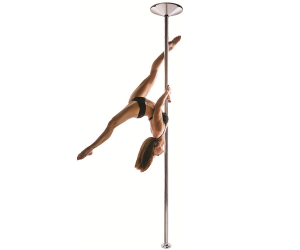Choosing The Right Poles For Your Studio
Choosing The Right Poles For Your Studio
As a pole and aerial studio owner, choosing the right pole and aerial equipment for your studio is critical. With lots of options to pick from, it can be a bit confusing as to which is the “right” one for your studio.
FIXED VS. REMOVABLE POLES
Poles today are either fixed (meaning semi or fully permanent), or removable. There are also free standing (stage poles), but they are not suited for a studio environment, and can be challenging for beginners to learn on. For studios, it is important that the poles are supported and do not move while you are using it. The poles must have the right stability to support your weight or another dancer.
For fixed poles, the bottom and top support is made up of a pair of brackets that are screwed into the floor and ceiling. The screws that are used to lock the pole will depend on the pole and floor/ceiling materials but most fixed dancing poles come with its own bolts and screws.
Fixed dancing poles are very secure but this will only be a great option if you are not planning to move it to another location, and highly recommended for studios (especially if you use the poles on spin mode) and safety.
Removable poles on the other hand use pressure and tension to secure them in place, and must be installed on a secure beam or joist in the ceiling which also supported by the sites like www.droppedceiling.co.uk. Instead of using screwed brackets, you can choose to put your pole almost anywhere where there is a beam or joist. This is a very practical option if you plan to practice your moves someplace else and perform in another.
Removable poles are not recommended for ceiling heights greater than 12 feet or for certain ceiling materials such as ceiling tile. Removable poles work very well for ceilings between 7’4″ and 12′. If you have ceiling tiles, bare studs, or vaulted ceilings; you can still have a removable or permanent pole mounted, you would just need to make minor alterations to your ceiling. (Vaulted ceiling adapters are available which can be noninvasive. Ceiling tiles can be moved out of the way or have holes cut in them for poles to mount beneath a sturdy surface.)
Either option choose, you must always check your poles daily, weekly, and monthly for signs of wear and tear, damages or scratches or if they seem to become unleveled or loose.
POLE MATERIAL
Poles are manufactured in several different materials/finishes. It’s good to know the differences between them all, so you can make the best decision on which finishes to have in your studio.
Chrome – Chrome poles are probably one of the most commonly found finishes in the industry. They are chrome plated smoothly from top to bottom, and contain a small trace amount of nickel in them, so students with an allergy to nickel may experience allergic reactions such as skin rashes and irritation.
Titanium Gold – Titanium Gold poles have a specialized coating which is electronically placed onto the pole to enhance the dancers grip. They are stickier than Chrome, but because it is a coating, it will rub off the parts of the pole that are used the most. These poles also contain trace amounts of nickel and can cause allergic reactions to those that are sensitive to it.
Brass – Brass poles are very grippy, and are most commonly used in more humid climates (think Australia!). It is a softer metal, and more prone to scratches/dents, and are priced higher than other poles. Brass poles also contain small amounts of nickel and can cause allergic reactions to those sensitive to it. Brass poles must also be cleaned with special brass cleaner to maintain its finish.
Powder Coated – Powder coated poles are painted poles, and provide an immense amount of grip. They are not recommended to be used for static drops, as the finish has been known to burn the skin. They can be made into many different colors and even patterns, and are safe for those that are allergic to the nickel in other pole finishes.
Silicone – Similar to a Chinese pole, the silicone texture provides maximum grip for pole holds, and clothing is recommended. MAXIMUM grip! Spins on static mode are not advised.
Stainless Steel – Stainless Steel poles should have a polished not brushed finish, as it is a slick metal (similar to, but more slippery than chrome). This pole contains no nickel and is the recommended finish for those allergic to nickel.
POLE SIZES
Poles are manufactured in several sizes: 50mm (2 inches), 45mm (1.75 inches), 40mm (1.57 inches) and 38mm (1.49 inches). 45mm poles are the recommended industry standard, however thicker poles are sturdier and more stable. The taller the poles are, the more they will start to flex and bend in the middle parts, so poles that are 45mm or thinner are not recommended to be higher than 10 feet, unless they are dual lined (meaning there is another supporting pole inside the pole). Poles thinner than 45mm should be made from toughened industrial steel, which can be more expensive than bigger poles.
SPINNING VS. STATIC MODE
Many dance poles now offer the “spinning” feature which allows you to let your pole spin freely. It’s a good idea to buy poles that offer this switch between static and spin, in the event you want to hold spinning or static classes. It is great to cross train on both modes, as they both create a different workout experience.
Some poles switch between modes using a pin that is inserted in the base, a screw that raises up into a divot in the pole base, or screws that tighten or loosen into the base. You can always switch from static to spin, depending on your curriculum.
POLE PRICING
Poles are a huge investment in your pole and aerial studio, so you do not want to cut corners here. Get the most bang for your buck. The price range of poles is so vast that you may be overwhelmed with options, or closed off into a corner with little selection. Generally speaking, the old adage “you get what you pay for” applies to dance/fitness poles, as well. The more expensive the pole, the higher quality and more features it boasts. But luckily, poles can be both high quality and affordable. Steer clear from novelty poles sold in joke shops, as these are very cheap and are not built for actual use. After all, a pole is a piece of exercise equipment and you do not want it to give out during use!
Stainless Steel and chrome tend to be the most affordable pole materials, with titanium gold and brass costing slightly more. However, the versatility of these pole materials often justifies the increased cost. Most pole companies will offer a studio discount, since you are probably ordering multiple poles at a time.
POLE BRANDS
There are several dance/sport pole manufacturers out there, and depending on what type of pole you pick for your studio, will determine which company you should order from. Poles come in single piece, or multi-piece poles, but it is recommended that you use single piece poles for your studio, as they are safer and easier to maintain than multi-piece poles. Here are a few reputable companies that manufacture dance/sport poles:
Which poles do you have in your studio? What brands/finishes/diameters are your favorite? We would love to hear your thoughts.



